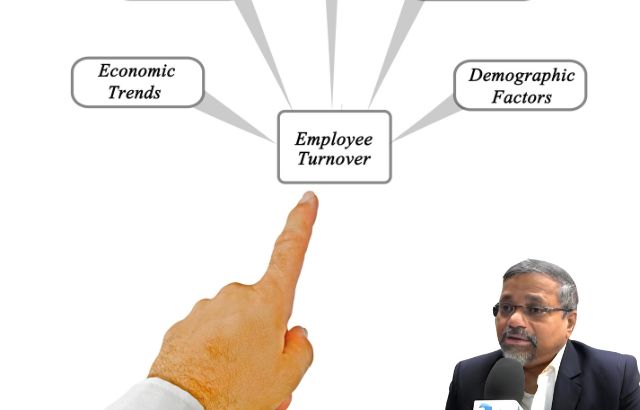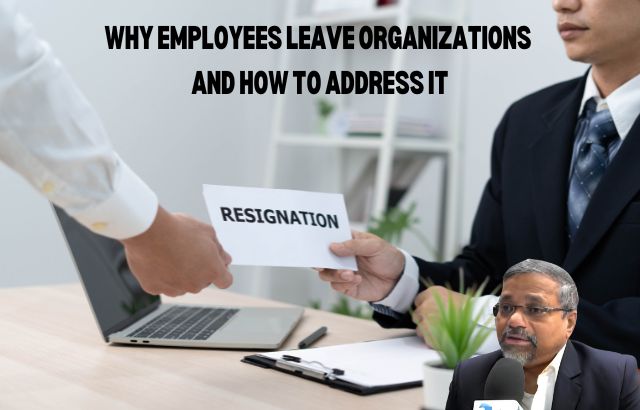Employee turnover is a common challenge for organizations, and it can be costly. Understanding why employees leave and how to address these issues is crucial for retaining talent and maintaining a productive, motivated workforce. There are several reasons why employees decide to part ways with their employer, and these reasons can often be grouped into six main categories: Personal, Professional Growth, Work Environment, Management and Leadership, Compensation and Benefits, and Job Fit. In this blog, we’ll explore each of these categories, provide examples, and discuss how to address these issues to improve retention.
1. Personal Reasons
Example:
Sometimes, employees leave due to personal reasons that are unrelated to their job. For instance, they might need to relocate for family reasons, such as a spouse’s job transfer, or they may need to care for a loved one.
How to Address It:
While you can’t always control employees’ personal circumstances, you can offer flexibility. Flexible working hours or remote work options can help employees balance their personal lives with their job responsibilities.
2. Professional Growth
Example:
An employee who feels stuck in a role with no opportunity for growth may leave for a job where they can advance. For example, a software developer might feel their skills are stagnating and might leave for a company that offers more opportunities for learning and advancement.
How to Address It:
Offer clear career advancement paths, mentorship programs, and continuous learning opportunities such as workshops or training. Encourage internal promotions to show employees that they can grow within the company.
Example Calculation:
Let’s assume a company has a training budget of $10,000 annually. If they invest in professional development for 50 employees, each employee will receive $200 worth of training, helping to improve skills and reduce turnover.
10,000 USD50 employees=200 USD per employee\frac{10,000 \, \text{USD}}{50 \, \text{employees}} = 200 \, \text{USD per employee}
3. Work Environment
Example:
A toxic work environment can lead to employees leaving. For example, employees may leave if they feel unsupported by their peers or if there’s excessive office politics, or a lack of collaboration.
How to Address It:
Promote a positive workplace culture through team-building activities, clear communication, and providing support for mental health. Encourage open communication, and ensure that employees feel heard and valued.
Example Calculation:
Companies with a strong workplace culture report 40% less turnover than those with poor culture. If a company with 100 employees has a turnover rate of 25%, this equates to 25 employees leaving annually. With a better work culture, that number could be reduced to 15 employees, saving on recruitment and training costs.
25−15=10 fewer employees leaving annually25 – 15 = 10 \, \text{fewer employees leaving annually}
4. Management and Leadership
Example:
Poor leadership is a significant factor in employee turnover. Employees may leave because they feel micromanaged or unsupported. For instance, an employee might leave if their manager fails to provide feedback or guidance.
How to Address It:
Provide leadership training to ensure that managers can effectively lead their teams. Implement regular feedback loops where employees can express concerns, and make sure managers are approachable and supportive.
5. Compensation and Benefits
Example:
Employees may leave if they feel their compensation is not competitive or their benefits package is lacking. For example, an employee might accept an offer from another company that provides better health insurance or a more attractive retirement plan.
How to Address It:
Conduct regular market research to ensure your compensation packages are competitive. Additionally, offer flexible benefits that cater to employees’ needs, such as health insurance, paid time off, and wellness programs.
Example Calculation:
Let’s assume an employee leaves because they receive an offer with a higher salary of $5,000 per year. By increasing your salary offer by just $2,000, you could have potentially retained this employee, saving the costs associated with recruitment and training.
Salary Increase=2,000 USD\text{Salary Increase} = 2,000 \, \text{USD}
6. Job Fit
Example:
Sometimes employees leave because the job isn’t a good fit for their skills or interests. For example, a graphic designer who prefers working on digital projects might leave a print-heavy company for one with more opportunities for digital design work.
How to Address It:
Ensure that employees’ roles align with their skills and career aspirations. During the hiring process, ensure the job description and expectations are clearly communicated, and regularly check in with employees to ensure their role continues to be a good fit.
Example Calculation:
A company hires an employee for a role that isn’t a good fit, leading to higher turnover. By ensuring that roles align with the candidate’s strengths, companies could reduce turnover by 10%.
100 employees×0.10=10 fewer employees leaving100 \, \text{employees} \times 0.10 = 10 \, \text{fewer employees leaving}
Understanding Employee Turnover-Ask Jaiguru

1. What are the main reasons employees leave their jobs?
Employees typically leave due to a combination of personal reasons, lack of career growth, poor work environment, management issues, compensation, and job fit. Identifying the root cause is key to addressing turnover effectively.
2. How can a company reduce employee turnover?
Companies can reduce turnover by offering career development opportunities, creating a positive work environment, ensuring competitive compensation, and aligning employees’ roles with their strengths.
3. Is employee turnover costly?
Yes, turnover is costly. It involves direct costs like recruitment and training, and indirect costs such as lost productivity and decreased employee morale. Reducing turnover can save companies a significant amount of money.
4. How can I improve employee engagement to reduce turnover?
Focus on open communication, provide recognition, offer career development opportunities, and create a work culture where employees feel valued and supported.
5. How can I determine if my compensation packages are competitive?
Regularly conduct market research to compare your company’s salaries and benefits with those offered by competitors in the same industry and region.
Surprising statistics on why employees leave organizations

Here are some interesting statistics on why employees leave organizations, based on various studies and surveys:
- Lack of Career Development Opportunities:
- 39% of employees who left their jobs cited lack of career advancement opportunities as the main reason for leaving. (Source: LinkedIn Workforce Learning Report)
- Salary and Benefits:
- 45% of employees in a survey said they would leave their current job for a higher salary, with compensation being a major driver of turnover. (Source: Glassdoor)
- Work-Life Balance:
- 32% of employees who left their jobs stated that work-life balance was a key factor in their decision to leave. (Source: Gallup)
- Lack of Recognition:
- 79% of employees who quit their jobs cite lack of appreciation or recognition as a significant factor in their decision to leave. (Source: Officevibe)
- Poor Company Culture:
- 63% of employees say they would consider leaving their current role if the company culture didn’t align with their values. (Source: Gallup)
- Toxic Leadership:
- 50% of employees report that a bad relationship with their manager was the primary reason for leaving their last job. (Source: Gallup)
- Unclear Expectations:
- 20% of employees who left said they did so because they felt their job expectations were unclear or unrealistic. (Source: Forbes)
- Inflexibility and Remote Work:
- 47% of employees said they would consider leaving their job if they were not offered flexible or remote work options. (Source: Deloitte)
- Lack of Autonomy:
- 41% of employees feel their need for autonomy is unmet at their current job, and this lack of control leads to higher turnover. (Source: Gallup)
- Burnout and Stress:
- 28% of employees who quit their jobs mention burnout as a critical reason for leaving. High workloads and stress were key contributors. (Source: Joblist)
These statistics highlight the importance of addressing factors such as career development, recognition, leadership, and work-life balance to reduce employee turnover and improve retention.
Gen Z Workplace Expectations: What Employers Should Know

As the youngest generation entering the workforce, Gen Z (born between 1997 and 2012) is reshaping the way organizations approach work culture, leadership, and employee engagement. With unique experiences, values, and aspirations, Gen Z employees bring new perspectives to the workplace. For employers looking to attract and retain this generation, understanding their expectations is crucial.
1. Work-Life Balance: Prioritizing Well-Being
One of the most important factors for Gen Z employees is work-life balance. Unlike previous generations that may have prioritized career success above all else, Gen Z is seeking flexibility and time for personal pursuits, hobbies, and mental well-being. They want to be able to maintain a healthy balance between their professional and personal lives.
Employer’s Role: To meet this need, employers can offer flexible working hours, remote work options, and mental health resources. Providing paid time off and promoting a culture where employees feel comfortable setting boundaries is essential for attracting and retaining Gen Z talent.
2. Purpose-Driven Work: Aligning with Values
Gen Z employees are passionate about making a positive impact on society. They expect employers to have strong corporate social responsibility (CSR) initiatives and demonstrate ethical practices. This generation is more likely to align themselves with organizations that prioritize sustainability, diversity, and inclusivity.
Employer’s Role: Organizations should be transparent about their values and actions toward sustainability and social justice. Employers can engage Gen Z employees by involving them in meaningful projects, providing opportunities for volunteer work, and showing their commitment to societal issues.
3. Technological Integration: Digital Fluency
Growing up with technology, Gen Z is highly tech-savvy and expects modern, user-friendly tools in the workplace. They value efficiency, collaboration, and convenience, often relying on digital communication platforms, cloud-based software, and mobile tools to do their work.
Employer’s Role: Employers should invest in the latest technology and digital tools that streamline workflows and promote collaboration. Offering training programs to keep employees up to date with emerging technologies can also be an effective way to empower Gen Z workers.
4. Career Development and Growth Opportunities
Gen Z is ambitious and highly motivated to advance in their careers. They want to feel that their work contributes to their personal and professional development. Opportunities for mentorship, training, and upward mobility are key factors in their decision to stay with an organization.
Employer’s Role: Employers can support Gen Z by offering clear career progression paths, mentorship programs, and opportunities for skill development. Regular performance feedback and recognition are also essential in keeping this generation engaged and motivated.
5. Diversity and Inclusion: Celebrating Differences
Diversity, equity, and inclusion (DEI) are top priorities for Gen Z employees. They seek workplaces that value people of all backgrounds, experiences, and identities. Gen Z wants to work in environments where they feel respected and can bring their full selves to work.
Employer’s Role: Employers should foster an inclusive workplace culture where diversity is celebrated and everyone has an equal opportunity to succeed. Implementing diversity training, creating employee resource groups, and ensuring equal pay are critical steps toward meeting Gen Z’s expectations.
6. Transparent Communication: Open and Honest Dialogue
Gen Z values transparency and open communication from their employers. They want to know about the company’s goals, challenges, and decision-making processes. This generation also prefers direct, clear communication and is quick to voice concerns when something doesn’t align with their values or expectations.
Employer’s Role: Employers can build trust with Gen Z employees by being open about organizational changes and encouraging feedback. Creating an open-door policy, holding regular meetings, and using digital platforms for communication can ensure that Gen Z feels heard and valued.
7. Fair Compensation: Competitive Pay and Benefits
While work-life balance and purpose are essential to Gen Z, fair compensation is still a key factor. This generation is highly attuned to financial security and values employers who offer competitive salaries, health benefits, and financial wellness programs.
Employer’s Role: Employers should offer competitive compensation packages that reflect the skills and experience of Gen Z employees. Benefits like health insurance, retirement plans, student loan assistance, and wellness programs can also be attractive to this generation.
FAQs: The Role of Green Innovators in Startup Success

1. How can a Green Innovator help my startup retain employees?
A Green Innovator can help your startup create a sustainable and environmentally responsible business model, which resonates with employees who care about the planet. This can improve job satisfaction, align roles with personal values, and foster a positive work environment.
2. Do employees care about sustainability in the workplace?
Yes, many employees, particularly millennials and Gen Z, value sustainability and want to work for companies that share their environmental values. By working with a Green Innovator to implement sustainable practices, startups can boost employee engagement and retention.
3. What are the benefits of hiring a Green Innovator for a startup?
A Green Innovator can help your startup reduce its carbon footprint, increase operational efficiency, and attract eco-conscious customers and employees. By embedding sustainability into your startup’s core, you can differentiate yourself in the market and foster loyalty from both employees and customers.
4. Can a Green Innovator help with both environmental goals and employee retention?
Absolutely. By creating a culture of sustainability, Green Innovators help startups achieve their environmental goals while simultaneously boosting employee morale, engagement, and retention.
5. How do green benefits impact employee retention?
Green benefits, such as eco-friendly commuting options, green office spaces, or sustainability-focused perks, show employees that their company shares their values. This can lead to higher job satisfaction and lower turnover rates.
Green Innovation as a Retention Strategy for Startups
Employee retention is critical to the success of any startup, and integrating sustainability through the expertise of green innovators can help address key factors that lead to turnover. By creating an environment where employees can grow professionally, enjoy a positive work environment, and align with sustainable practices, startups can foster loyalty, reduce turnover, and ultimately thrive in a competitive market. Partnering with green innovators as consultants for sustainable practices isn’t just good for the planet—it’s also an investment in your employees’ happiness and your startup’s future.












